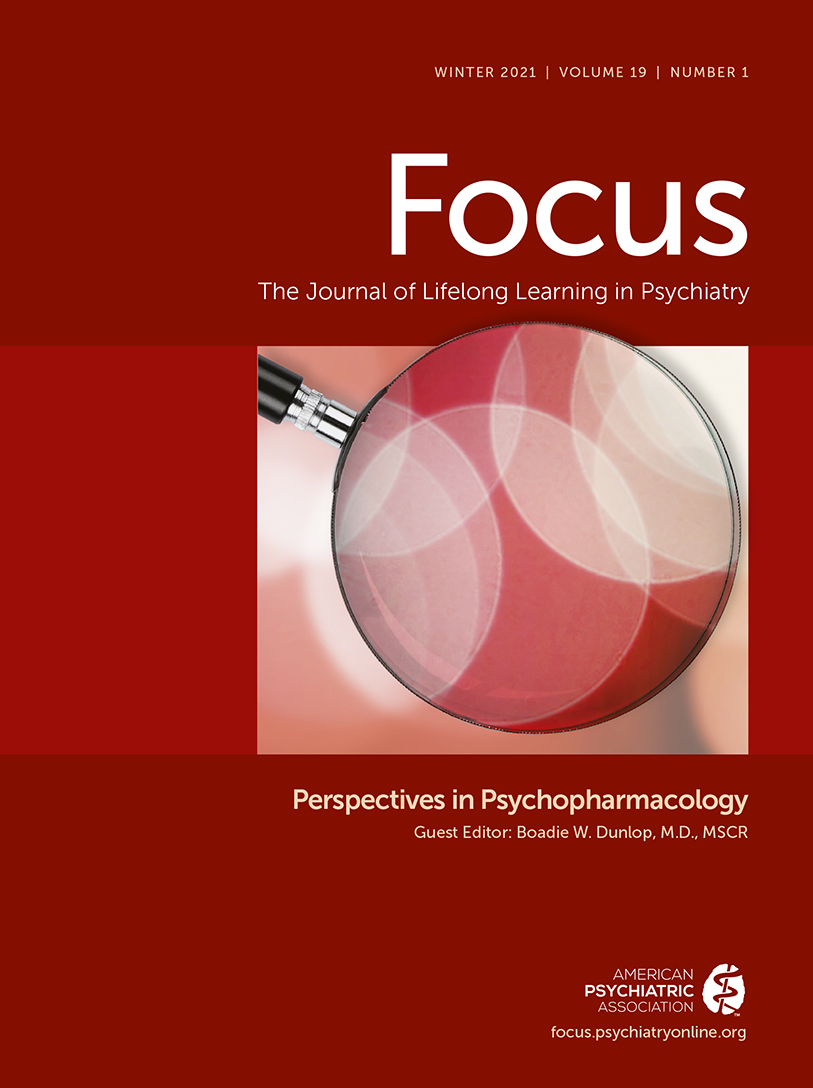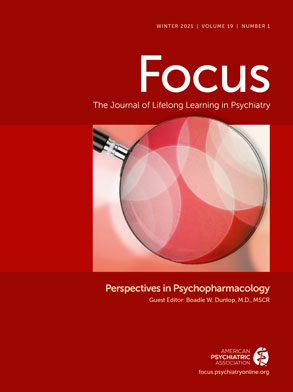Since the introduction of lithium in 1949, the number of medications available to treat psychiatric illnesses has steadily increased, providing modern clinicians a sizeable armamentarium of medications with diverse formulations, mechanisms of action, and targets. Concurrently, over the past 3 decades, the practice of outpatient psychiatry has moved away from psychotherapy toward medication management (
1,
2) and more complex psychopharmacologic regimens (
3). To be successful in this climate, a psychiatrist must be able to select the appropriate pharmacologic option(s) for the patient, drawing from a long list of old and new psychotropics while taking into account variables such as a patient’s comorbid medical conditions and potential drug-drug interactions. The psychiatrist must know how to prescribe the medicine, striking a balance between tolerability and efficacy. Finally, he or she must know how to respond to adverse events, nonadherence, or breakthrough symptoms that may develop with time.
These skills are likely taught to varying degrees in American psychiatric residency training programs. A national survey study of postgraduate year (PGY)-3 and PGY-4 psychiatry residents revealed that many of the respondents failed to initiate mood stabilizers, including lithium, valproate, carbamazepine, and lamotrigine, for their patients with bipolar disorder in their most recent training year (
4). The lack of consistency among programs may be due to the absence of specific, detailed program requirements for psychopharmacology training established by the Accreditation Council for Graduate Medical Education (ACGME) (
5). Additionally, the inconsistency may be due to the lack of faculty with psychopharmacologic expertise or of specialty clinics for illnesses such as treatment-resistant schizophrenia or bipolar disorder at various residency programs across the country. In a survey of U.S. psychiatry residency program directors, 34% reported a need to enhance their program’s overall psychopharmacology curriculum (
6). With the growing need to provide robust and effective psychopharmacology training, psychiatric educators over the past 20 years have developed and published several innovations in the form of pedagogical practices and assessment strategies. I review these innovations next and then offer future considerations to help program directors and educators strengthen psychopharmacology training for the psychiatrists of the next generation.
Pedagogy
The pedagogical approaches to teaching psychopharmacology consider which topics to teach (content) and how to teach them (methods). Over the past 20 years, several psychopharmacology publications have described innovations in both areas. Regarding content, educators have reported their experiences teaching a wide range of topics, including the psychodynamics of psychopharmacology, which explores how the psychosocial factors in the doctor-patient relationship influence medication effectiveness (
7); biological psychiatry, which combines neurosciences and psychopharmacology (
8,
9); the psychopharmacological treatment of various psychiatric illnesses (
10,
11) and their established treatment algorithms (
9); the evaluation of psychopharmacology clinical trials (
9,
12); the nuances around prescribing clozapine and managing side effects (
13); the assessment and management of medication nonadherence (
14); and the informed consent process for initiating new medications (
15).
The majority of these topics are contained within the American Society of Clinical Psychopharmacology (ASCP) Model Psychopharmacology Curriculum, which consists of a comprehensive collection of lectures on various topics related to psychopharmacology. This curriculum originated in 1984 and has been updated every 2 years (
16). The most recent list of included lectures can be found on the ASCP website (
https://ascpp.org/resources/educational-resource/ascp-model-psychopharmacology-curriculum-seventh-edition). In addition to many of the topics listed earlier, the curriculum also includes lectures on the art of psychopharmacology, cross-cultural psychiatry, combining psychotropics with psychotherapy, ethical issues in psychopharmacology, and industry interactions (
17).
In regard to the methods for teaching these topics, various strategies have been reported that incorporate principles of adult learning, including the need for learners to be active and self-directed (
8). Most of the publications reported earlier describe multimodal educational efforts that usually have some lecture or didactic component as a starting point. For example, in addition to the lectures, the ASCP Model Psychopharmacology Curriculum and University of Massachusetts biological psychiatry seminars include additional elements such as journal clubs, problem-based learning, games, and case conferences (
8,
10,
11). When teaching residents the components of the informed consent process for initiating new medicines, Kavanagh et al. (
15) used a combination of role-playing exercises and group discussion. Weiden and Rao (
14) also used role-playing activities along with case vignettes and lectures to teach residents how to assess and manage medication nonadherence. To train residents in the use of clozapine, Freudenreich et al. (
13) worked with PGY-2 residents in a clozapine specialty clinic over 6 weeks. The residents received clozapine specific didactics in a small group session at the beginning of every clinic and then immediate supervision and feedback after each patient encounter. Finally, Mohr et al. (
12) developed a 23-item appraisal instrument to guide residents through a systematic assessment of psychopharmacologic clinical trials.
Assessment
Assessment is a vital component of psychopharmacology training because it provides essential feedback to stakeholders (i.e., residents, faculty, program directors, state licensing boards, specialty certification boards). Across most residency programs, assessment in psychopharmacology knowledge and skills occurs via the Psychiatry Residency In Training Exam (PRITE) and the ACGME Psychiatry Milestones assessment, both of which present limitations (
18). Assessment can be divided into two broad categories: formative and summative. Formative assessments provide the student and teacher with data about the student’s progress and can help the student become more self-directed and accelerate their learning (
19). Summative assessments provide an overall evaluation of the student’s mastery of the material at the completion of the course (
20). Both types of assessment are fundamental to psychiatric training and have been developed for use in psychiatric residency programs.
Among formative assessments, Young et al.’s (
21) Psychopharmacotherapy-Structured Clinical Observation (P-SCO) instrument stands out. This 27-item checklist includes essential tasks to be completed during a psychiatric medication management visit. Faculty observe residents during clinic visits and indicate whether and to what degree residents complete the 27 tasks. The faculty member then provides specific feedback to the resident. Compared with global assessments of resident performance, the P-SCO assessments provided residents 3.3 times more patient-care specific comments, particularly for corrective and reinforcing comments. A follow-up study provided additional validity evidence with respect to the tool’s internal structure and its correlation with resident experience (
22). Another formative assessment includes measuring residents’ confidence levels initiating and managing the side effects of various psychotropics. Rakofsky et al. (
23) showed that confidence prescribing medicines from particular classes of psychotropics varied with experience prescribing those medicines over a 12-month academic year. By eliciting residents’ confidence levels early in the academic year, educators can tailor the training experience to boost those levels where it is most needed.
In the category of summative assessments, a few of the curricula described earlier include pre- and postassessments to ensure that residents mastered the content (
13,
24). A more recent publication describes the creation of a virtual standardized patient-based assessment tool to evaluate psychiatric residents’ psychopharmacology proficiency in the treatment of major depressive disorder (
18). The tool is an online simulator that replicates the outpatient psychiatric clinic experience. The virtual patient reports symptoms of a treatment-resistant form of depression, and the resident is required to use various antidepressants until the patient finally remits. The resident earns points for correct responses to questions asked by the virtual patient about topics such as dosing, titration decisions, and side effects.
Future Considerations
The innovations in pedagogy and assessment reported earlier address a variety of topics in psychopharmacology, learning styles, and assessment types. However, opportunities are available to add to these innovations and continue improving psychopharmacology education. Integrating the neuroscience-based nomenclature (NbN) into residency education may be one such innovation. The NbN was developed in 2008 by a task force of scientific organizations including the American, Asian, European, and International Colleges of Neuropsychopharmacology and the International Union of Basic and Clinical Pharmacology (
25). Its goal is to reclassify psychiatric medicines on the basis of their neuronal targets rather than their clinical indications. The task force has developed a free app, which is updated every 2 years, that provides detailed information about the pharmacology and mode of action of psychiatric medicines. Residency lectures and communications between attending physicians and residents can incorporate these new classifications, helping residents learn the new terminology and improve their understanding of how these medications work.
Another opportunity stems from the lack of specific, detailed psychopharmacology program requirements established by the ACGME. Residents’ psychopharmacology education may benefit from a national expert consensus–defined list of psychopharmacology learning objectives. The ASCP Model Psychopharmacology Curriculum is comprehensive and likely addresses the learning objectives that would be included; however, one of the limitations to the curriculum has been educators’ reluctance to replace their own lecture material with that provided by the ASCP (
24). Developing only a defined set of learning objectives would provide residency programs a guide for the topics they should teach and the flexibility to teach them in the manner they choose. Psychiatric educators in Europe have proposed such a list, providing topics ranging from basic principles of pharmacology to the implementation and application of these medications in the treatment of various psychiatric illnesses. They also provide the number of hours that should be dedicated to teaching those topics (
26).
Building on Freudenreich et al.’s (
13) example, residency programs can identify psychiatric specialty clinics within their institution (e.g., clozapine, women’s mental health, bipolar disorder, treatment-resistant depression) and seek opportunities for their residents to work in those settings. Incorporating more digital technology—such as audience response systems, apps, video telecommunications to include patients or expert psychopharmacologists, and other tools—will ensure that presentations are multimodal and interactive, consistent with adult learning theories.
In the realm of assessment, developing virtual standardized patient simulators focusing on the treatment of psychiatric illnesses besides major depressive disorder, including bipolar disorder, schizophrenia, and obsessive-compulsive disorder, would provide additional opportunities to evaluate a resident’s psychopharmacologic proficiency. Developing a national exam for residents that focuses exclusively on psychopharmacology knowledge (similar to the ASCP Exam in Advanced Clinical Psychopharmacology) may be an opportunity to widen the scope of psychopharmacology knowledge assessment beyond that of the PRITE.
Finally, more research in psychopharmacology education is needed. Studies that identify the extent and depth of U.S. residents’ psychopharmacology knowledge will help determine how well American residency programs are preparing their graduates. Scores on the PRITE psychopharmacology questions can shed some light on this question. Research on the most effective methods for teaching psychopharmacology is also greatly needed to help educators select the optimal approach for training residents, taking into account PGY level and adult learning theories.
Conclusions
The increased role of psychopharmacology in the practice of psychiatry is leading psychiatric educators to shift their focus to ensure that psychiatric residents can competently prescribe and manage the side effects of a diverse range of psychotropic medications. Fortunately, the past 20 years have seen an increase in the number of publications reporting innovations in the areas of psychopharmacology curricula topics, teaching strategies, and assessments of psychopharmacology knowledge and skills. Psychiatric training programs can benefit from and build on these innovations, ensuring that all physicians graduating from a psychiatric residency program meet psychopharmacology-based learning objectives and that their learning can be measured in valid and reliable ways.

